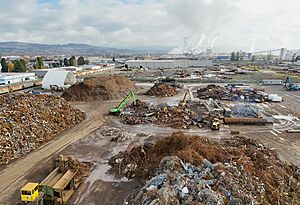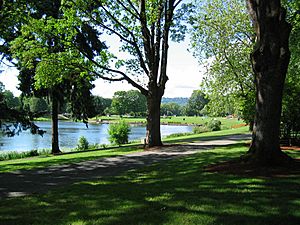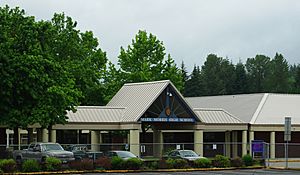Longview, Washington facts for kids
Quick facts for kids
City of Longview
|
|
|---|---|

Downtown Longview
|
|
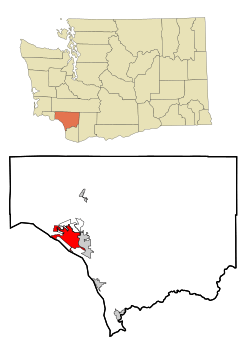
Location of Longview, Washington
|
|
| Country | United States |
| State | Washington |
| County | Cowlitz |
| Settled | 1850s |
| Incorporated | February 14, 1924 |
| Government | |
| • Type | Council-Manager |
| Area | |
| • City | 15.33 sq mi (39.71 km2) |
| • Land | 14.79 sq mi (38.30 km2) |
| • Water | 0.54 sq mi (1.41 km2) |
| Elevation | 20 ft (6 m) |
| Population
(2020)
|
|
| • City | 37,818 |
| • Density | 2,599.58/sq mi (1,003.73/km2) |
| • Metro | 110,730 (US: 345th) |
| Time zone | UTC-8 (PST) |
| • Summer (DST) | UTC-7 (PDT) |
| ZIP codes |
98632
|
| Area code | 360 |
| FIPS code | 53-40245 |
| GNIS feature ID | 1506304 |
Longview is a city in Cowlitz County, Washington, United States. It is the biggest city in Cowlitz County. In 2020, about 37,818 people lived there.
Longview is in southwestern Washington. It is where the Cowlitz and Columbia rivers meet. The city of Kelso is right next to Longview on its east side. The Cowlitz Indian Tribe, a Native American group, has its main office in Longview.
In 1918, a man named Robert A. Long bought a lot of timberland in this area. His company, Long-Bell Lumber, planned to build two huge mills. They needed 14,000 workers to run the mills and lumber camps. This was too many people for nearby towns to handle. So, in 1921, Long decided to build a brand new city. He wanted it to be a place where up to 50,000 people could live. This new city would provide workers for the mills and attract other businesses. Robert A. Long even paid for some of the city's important buildings himself.
Contents
History of Longview
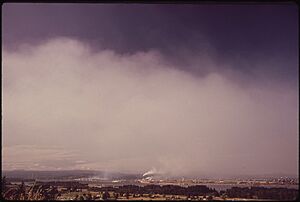
Longview was once the site of Mount Coffin. This was a special burial ground for the local Native American people.
Early Settlements and Names
The first European-American settlers arrived in 1849. They were led by Harry and Rebecca Jane Huntington. The area was first called Monticello. This name honored Thomas Jefferson's home in Virginia.
In 1852, a group met in Monticello. They asked the U.S. Congress to make the area a state. They wanted to call it "Columbia." Congress agreed to make it a state but named it Washington. This was to avoid confusion with the District of Columbia. A monument to this meeting is near the Longview Civic Center.
From 1854 to 1865, Monticello was the main town of Cowlitz County. But in 1867, the Cowlitz River flooded and destroyed the town. In 1865, Nathaniel Stone started a new town called Freeport. It was about a mile upriver from Monticello. Freeport became the county seat until 1872. Today, the areas of both Monticello and Freeport are part of Longview.
For nearly 60 years, the area had very few people. It was mostly farms and wild land.
Building a Planned City
In 1918, a rich timber owner named Robert A. Long from Missouri decided to move his business west. His company, Long-Bell Lumber, was running out of trees in the south. By 1921, they planned to build a large mill near Kelso, Washington. Kelso was a small town with only about 2,000 people. It could not support the 14,000 workers needed for the new mill.
So, the Long-Bell company hired George Kessler, a city planner. He designed a whole new city to support the two mills. Kessler planned the city like the nation's capital, Washington D.C. It followed ideas from the "City Beautiful movement" of the early 1900s.
Longview officially became a city on February 14, 1924. It was special because it was the only planned city of its size built entirely with private money. Robert A. Long personally bought several important buildings. These included R. A. Long High School, the Longview Public Library, the YMCA building, and the Monticello Hotel.
Growth and Challenges
Longview grew very fast from 1923 to 1934. It went from a few thousand people to the fourth largest city in Washington state by the 1930s. However, the Great Depression slowed down its growth.
During World War II, the Port of Longview became very important. It was a key place for loading cargo for the war in the Pacific.
On January 3, 1923, a sad event happened. The Allen Street Bridge, a wooden bridge connecting Longview and Kelso, collapsed. This was the deadliest bridge disaster in Washington state's history. The bridge fell because of high river waters, a log jam, and its poor condition. Seventeen people died in this accident.
In the 1960s, new neighborhoods were built in the western valley. The local economy changed in the 1970s and 1980s. Lumber companies started using machines more, which meant fewer jobs. There was a small economic boost in the early 2000s. But this ended with the Great Recession later that decade.
Recently, local groups have been working to create a new plan for the city. They want to help Longview grow and offer more affordable homes.
Geography and Climate
Longview covers about 14.79 square miles (38.30 square kilometers). Most of this is land, with a small amount of water.
The Lewis and Clark Bridge crosses the Columbia River. It connects Longview to Rainier, Oregon. This is the only bridge over the Columbia River between Portland and Astoria, Oregon.
Weather in Longview
Longview is in a small valley. Its weather is a bit different from nearby Portland, Oregon. Longview is usually about 7 degrees Fahrenheit (4 degrees Celsius) cooler than Portland.
Because it's about 80 miles (129 km) inland, Longview often has cloudy skies. This is due to moisture from the Pacific Ocean. The Columbia River gorge allows air to move between eastern and western Washington. This can cause strong winds, especially in summer evenings. Gusts can reach 30 to 40 mph (48 to 64 km/h). Sometimes, gusts have been over 100 mph (160 km/h) in higher areas.
Fall is often cool and foggy. Sometimes the fog stays all day. By November, it starts to rain a lot, like typical Northwest weather. Winter is chilly and rainy. There can be strong windstorms. Sometimes, very warm air from the "Pineapple Express" brings temperatures of 65 to 70 degrees Fahrenheit (18 to 21 degrees Celsius). This can also bring 3 to 6 inches (76 to 152 mm) of rain in a few days. Longview usually gets one or two snowfalls each year. They are often less than 6 inches (15 cm). Spring is warmer but still a bit wet. This is when thunderstorms happen most often.
| Climate data for Longview | |||||||||||||
|---|---|---|---|---|---|---|---|---|---|---|---|---|---|
| Month | Jan | Feb | Mar | Apr | May | Jun | Jul | Aug | Sep | Oct | Nov | Dec | Year |
| Record high °F (°C) | 65 (18) |
73 (23) |
81 (27) |
90 (32) |
99 (37) |
100 (38) |
105 (41) |
108 (42) |
104 (40) |
90 (32) |
77 (25) |
66 (19) |
108 (42) |
| Mean daily maximum °F (°C) | 45.3 (7.4) |
50.4 (10.2) |
55.2 (12.9) |
60.8 (16.0) |
67.2 (19.6) |
71.8 (22.1) |
77.6 (25.3) |
77.9 (25.5) |
73.3 (22.9) |
63.1 (17.3) |
52.2 (11.2) |
46.2 (7.9) |
61.8 (16.6) |
| Mean daily minimum °F (°C) | 33.1 (0.6) |
34.3 (1.3) |
36.4 (2.4) |
39.2 (4.0) |
43.7 (6.5) |
48.4 (9.1) |
51.5 (10.8) |
51.8 (11.0) |
48.8 (9.3) |
43.4 (6.3) |
37.9 (3.3) |
34.6 (1.4) |
41.9 (5.5) |
| Record low °F (°C) | −6 (−21) |
2 (−17) |
19 (−7) |
24 (−4) |
27 (−3) |
30 (−1) |
32 (0) |
35 (2) |
29 (−2) |
24 (−4) |
8 (−13) |
4 (−16) |
−6 (−21) |
| Average precipitation inches (mm) | 6.28 (160) |
4.79 (122) |
4.7 (120) |
3.35 (85) |
2.61 (66) |
2.07 (53) |
0.81 (21) |
1.3 (33) |
2.06 (52) |
3.98 (101) |
6.65 (169) |
7.11 (181) |
45.72 (1,161) |
| Average snowfall inches (cm) | 3.2 (8.1) |
0.8 (2.0) |
0.4 (1.0) |
0 (0) |
0 (0) |
0 (0) |
0 (0) |
0 (0) |
0 (0) |
0 (0) |
0.2 (0.51) |
0.6 (1.5) |
5.1 (13) |
| Average precipitation days (≥ 0.01 inch) | 21 | 18 | 20 | 17 | 13 | 11 | 5 | 6 | 9 | 15 | 20 | 22 | 177 |
Population and People
| Historical population | |||
|---|---|---|---|
| Census | Pop. | %± | |
| 1930 | 10,652 | — | |
| 1940 | 12,385 | 16.3% | |
| 1950 | 20,339 | 64.2% | |
| 1960 | 23,349 | 14.8% | |
| 1970 | 28,373 | 21.5% | |
| 1980 | 31,052 | 9.4% | |
| 1990 | 31,499 | 1.4% | |
| 2000 | 34,660 | 10.0% | |
| 2010 | 36,648 | 5.7% | |
| 2020 | 37,818 | 3.2% | |
| 2021 (est.) | 37,824 | 3.2% | |
| U.S. Decennial Census 2020 Census |
|||
In 2020, Longview had 37,818 people and 15,913 households. Most people (83.8%) were White. About 10.4% of the population was of Hispanic or Latino background.
About 22% of the people were under 18 years old. People over 65 made up 20.8% of the population. Slightly more than half (52.4%) of Longview's residents were female.
The average household income was $53,044. About 13.7% of the people lived below the poverty line.
Economy and Jobs
About 19% of the jobs in Longview are in manufacturing. The city has good access to the Columbia River, Interstate 5, and train lines. This has helped many different types of manufacturing businesses come to Longview.
There are many trees around Longview. This provides materials for companies like Weyerhaeuser and Kapstone, which work with timber. Other big manufacturers in Longview include NORPAC (newsprint), Solvay Chemicals (making hydrogen peroxide), and Westlake Chemical.
Sports and Recreation
Local Sports Teams
The Cowlitz Black Bears baseball team plays in Longview. They are part of the West Coast League, a summer baseball league. Their games are held at David Story Field, which is on the Lower Columbia College campus.
Parks and Fun Things to Do
Longview has many parks and places for fun. The Longview Parks and Recreation department takes care of these areas. A famous park is Lake Sacajawea. Many other parks in the city have walking trails, sports fields, and play areas for kids. Both Longview and Kelso have skateparks.
There are also two athletic clubs: the YMCA and Mint Valley Racquet and Fitness. Golf courses include Longview Country Club and Mint Valley. The Parks and Recreation department also offers programs for young people. These include after-school programs and a center called The Boulevard for teens.
Education in Longview
Longview has its own public school system, Longview Public Schools. It has eight elementary schools, three middle schools, and two high schools. The high schools are R. A. Long and Mark Morris.
There are also two private religious schools. St. Rose Catholic school teaches students from kindergarten to eighth grade. Three Rivers Christian School has two campuses. One is for younger students (preschool to sixth grade), and the other is for older students (seventh to twelfth grades).
Lower Columbia College (LCC) is a college located in Longview. It was started in 1934.
Culture and Events
Go Fourth Fest
Every year on Independence Day (July 4th), Longview hosts the Go Fourth Fest at Lake Sacajawea. More than 30,000 people come to enjoy the festival. There are food booths, live music, and exhibits around the lake. The festival also has a parade that starts downtown and ends at the park. The day finishes with a big fireworks show.
Historic Buildings and Places
Longview has many historic buildings. Many of them were built between 1923 and 1934. These buildings show different styles, like Georgian-revival, Tudor, craftsman, and Art Deco.
Several places in Longview are listed on the National Register of Historic Places. This includes a park, a bridge, and many buildings. The Civic Center is also a National Register Historic District. Some of these historic places are:
- Berwind-Purcell House
- Big Four Furniture Building
- Columbia Theatre
- First Christian Church
- Lake Sacajawea Park
- R. A. Long High School
- Longview Bridge (also known as the Lewis and Clark Bridge)
- Nutty Narrows Bridge
- Longview Civic Center Historic District
- Longview Community Church
- Longview Community Store
- Longview Women's Clubhouse
- Mills Building
- Pacific Telephone and Telegraph Building
- Pounder Building
- Schumann Building
- Sevier and Weed Building
- J. D. Tennant House
- Tyni Building
- US Post Office – Longview Main
- Washington Gas and Electric Building
- Willard Building
Transportation in Longview
Longview is located on the I-5 Corridor, a major highway. It is also served by State Route 4 and State Route 432. These roads connect Longview to nearby Kelso and Wahkiakum County. State Route 433 connects Longview to Rainier, Oregon, across the Lewis and Clark Bridge.
Public Transit
The city has a local bus system called RiverCities Transit. It travels between Kelso and Longview. The closest train and bus station is the Kelso Multimodal Transportation Center. You can catch Amtrak passenger trains like the Cascades and Coast Starlight there.
Port of Longview
The Port of Longview was started in 1921. It has eight marine terminals. These terminals handle many different types of cargo. This includes windmills, lumber, grain, logs, and steel. The Port is 66 miles (106 km) from the Pacific Ocean.
Nutty Narrows Bridge for Squirrels
Longview is famous for the Nutty Narrows Bridge. It was built in 1963 by Amos Peters. This bridge was made just for squirrels! Its purpose was to help squirrels cross busy streets safely. For many years, it was the only bridge in the world built only for squirrels.
Since 2011, Longview has a yearly festival called Squirrel Fest. As part of this festival, new squirrel bridges have been added. As of 2023, there are now seven squirrel bridges in the city.
Recognition and Fun Facts
In 2012, Forbes magazine said Longview was one of the prettiest cities in the United States.
The band Green Day has a song called "Longview" on their album Dookie. The song is named after the town.
Notable People from Longview
Many interesting people have come from Longview:
- Bud Black, a baseball manager for the Colorado Rockies.
- Steve De Jarnatt, a director of movies like Miracle Mile.
- James Phillip Fleming, who received the Medal of Honor for his bravery as a helicopter pilot in the Vietnam War.
- David Korten, an author.
- Trevor May, a baseball pitcher for the Oakland Athletics.
- Hal Riney, a famous advertising executive.
- Rick Sweet, a Minor League Baseball manager.
- Moulton Taylor, who invented the Aerocar, a car that could also fly!
- Brian Thompson, an actor known for action films.
- David Walden, a computer scientist who helped create the early internet.
Sister City
Longview has one sister city:
Gallery
See also
 In Spanish: Longview (Washington) para niños
In Spanish: Longview (Washington) para niños


